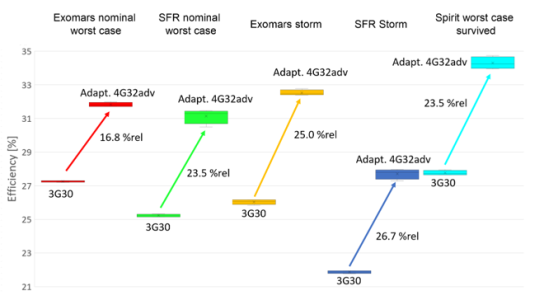Performance optimisation and evaluation for next generation solar cells under Martian Environment

To develop/optimise/characterise solar cell concepts with the highest performances under Martian conditions,compatible with flexible solar array concepts and increasing specific power
Solar cells for space applications are typically designed to provide highest performance values at End of Life (EOL) conditions, meaning after a typical to be expected degradation due to particle irradiation and under a constant sun spectrum without perturbation by any atmosphere. Typically, these solar cells are used without modification also for Martian missions. However, due to the fact that the spectral conditions on Mars are significantly different from typical space missions, those solar cells are not at all optimised for providing highest performances. Therefore, a dedicated activity is needed to develop new and/or optimise existing solar cell concepts for reaching highest performances under Martian conditions with a significantly lower expectable degradation due to particle irradiation. As an additional feature, those solar cells shall be compatible with flexible solar array concepts which will become the baseline concept for future Mars missions when compact stowage will be one of the mission drivers. The aim of this activity is also the development of a model which allows for a performance prediction under any Martian environment and to demonstrate by testing the superiority of the new solar cell structure in comparison to state-of-the-art space solar cells.The activity encompasses the following tasks:- Theoretical identification of optimised solar cell structures - Development of best suited solar cell structure or optimisation of existing solar cell structures for Martian applications.- Production of initial test samples- Preliminary assessment of performance on the basis of test samples.
